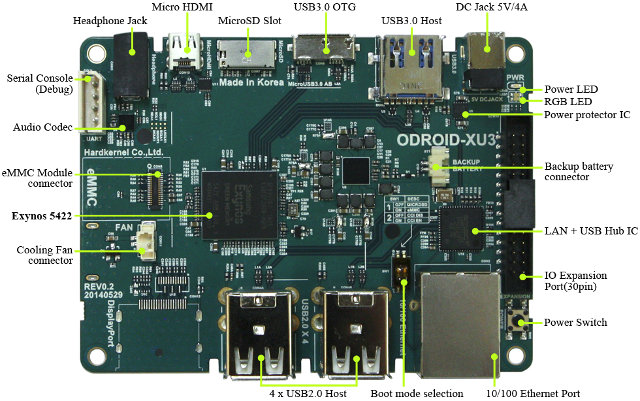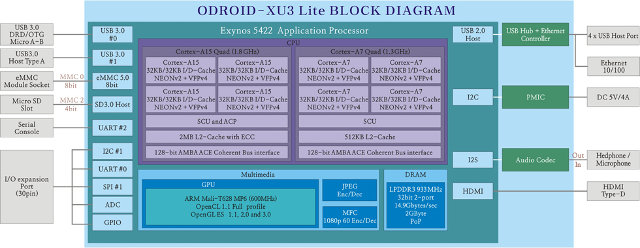Hardkernel is known for their low cost Exynos based ODROID boards such as the $59 ODROID U3 board based on Exynos 4412 quad core SoC, and with ODROID-XU3, they also have a more powerful Octa-core Exynos 5422 board which sells for a premium price of $179. The company has now decided to offer a cheaper version of the board, which they call “ODROID-XU3 Lite” and lacks DisplayPort, the current and voltage sensors, and uses an Exynos 5422 processor clocked at 1.8/1.3 GHz instead of 2.0+/1.4 GHz for the original board. Price? A cool $99.
 ODROID-XU3 Lite specifications:
ODROID-XU3 Lite specifications:
- SoC – Samsung Exynos 5422 quad core ARM Cortex-A15 @ 1.8GHz quad core ARM Cortex-A7 @ 1.3GHz in big.LITTLE configuration with Mali-T628 MP6 GPU supporting OpenGL ES 3.0 / 2.0 / 1.1 and OpenCL 1.1 Full profile
- System Memory – 2GB LPDDR3 RAM PoP (933Mhz, 14.9GB/s memory bandwidth, 2x32bit bus)
- Storage – Micro SD slot (up to 64GB) + eMMC 5.0 module socket. Optional eMMC module reach 198MB/s (read) and 74MB/s (write)
- Video Output – micro HDMI 1.4a, up to 1080p60.
- Audio Output – micro HDMI and 3.5mm headphone jack
- Network Connectivity – 10/100Mbps Ethernet (Via LAN95144 USB + Ethernet controller)
- USB – 1x USB 3.0 host port, 1x micro USB 3.0 OTG port, 4x USB 2.0 host ports
- Expansion – 30-pin header for access to GPIO, IRQ, SPI and ADC signals
- Debugging – Serial console header
- Misc – Power and RGB LEDs, cooling fan header
- Power Supply – 5V/4A power adapter using 5.5/2.1mm barrel, external backup battery.
- Dimensions – PCBA: 94x70x18mm; Enclosure: 98x74x29mm
The company also offers optional USB 2.0/3.0 dongles for Wi-Fi, Gigabit Ethernet, and SATA.

You can run Ubuntu 14.04 with OpenGL ES and OpenCL support or Android 4.4.x both on top of Linux kernel 3.10 LTS. ODROID-XU3 achieves 50,313 points in Antutu 5.1, and although the core for the Lite should be slightly lower due to the lower operating frequency, it still means you’ll get one of the fastest devices available.
ODROID-XU3 Lite comes with a 5V/4A power supply, an enclosure, a heatsink, and a fan, just like the original version, and you can purchase it directly from Hardkernel, or if your live in the US or Europe receptively via Ameridroid or Pollin Electronics. Bear in mind there;’s no storage, so you’ll either need to use a (Class 10) micro SD card, or for even faster performance, purchase one of the eMMC module for an extra $39 to $79.

Jean-Luc started CNX Software in 2010 as a part-time endeavor, before quitting his job as a software engineering manager, and starting to write daily news, and reviews full time later in 2011.
Support CNX Software! Donate via cryptocurrencies, become a Patron on Patreon, or purchase goods on Amazon or Aliexpress




